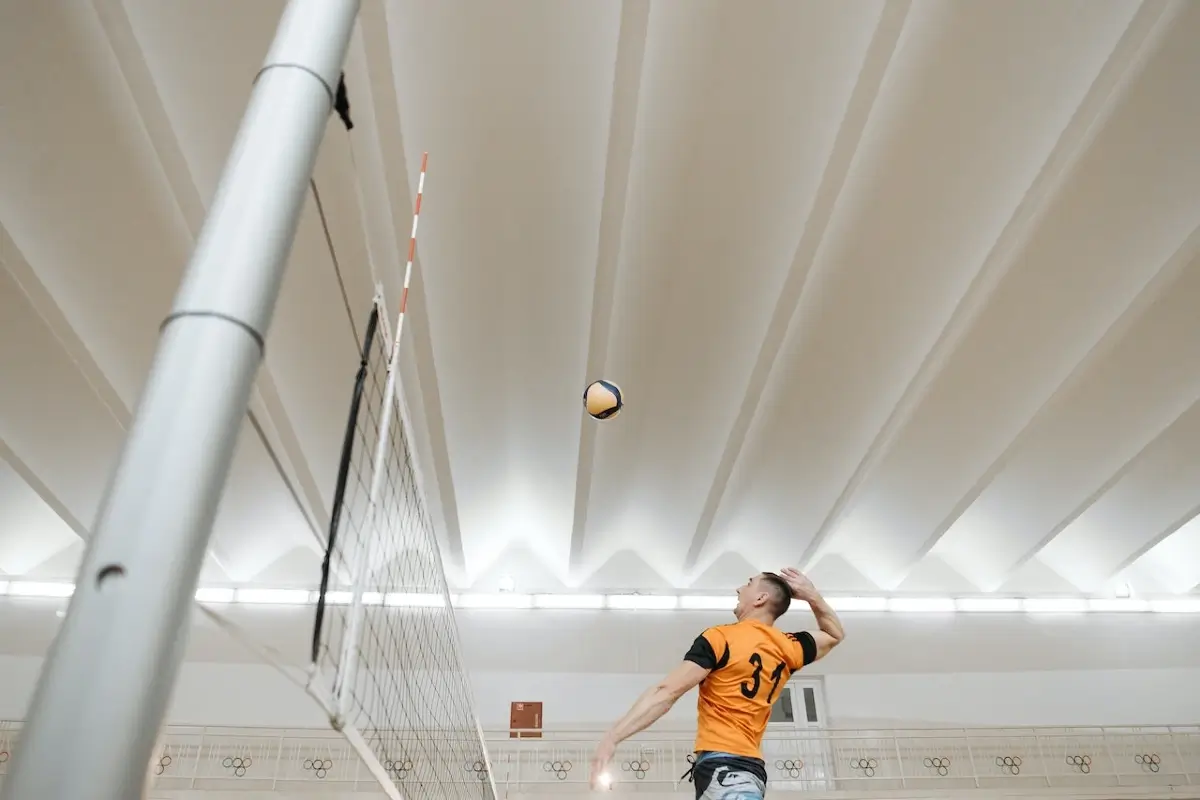Last Updated: January 12, 2024
Volleyball spiking is an exciting way to execute a shot. Almost every volleyball player out there loves to jump up high and hammer the ball to the opponent’s side of the net to score points.
However, only a few players get the technique right.
Here are the five spiking mistakes that players make most often, with solutions to correct them.
5 Common Spiking Mistakes

1. Weak Arm Swing
Handling a spike derived from a weak arm swing is nothing less than a joke for strong blockers. In all seriousness, strong blockers can redirect weak spikes back into your side of the net without throwing a sweat.
After all, they are used to handling high-velocity incoming balls. The point here is that a strong-arm swing is a must to pack some power behind your spike. Even experienced and well-positioned blockers find it difficult to defend or block a powerful spike.
Correcting the weak arm swing
To correct or strengthen a weak arm swing, focus on strength training exercises. Backed by strong muscles, you can produce a great amount of force, resulting in a powerful spike. The best part is that high-velocity spikes can pass through the blocker’s hands, leading to successful point scoring even against well-positioned blockers.
Technique improvement is also critical. Therefore, you must work on your volleyball spiking technique, especially ball-timing and follow-throughs. A video analysis will help a great deal in reviewing and correcting your spiking technique. As you refine your volleyball skills, your muscle memory will improve, allowing you to harness the full potential of a strong-arm swing.
2. Not Enough Variation
When your spiking approach becomes predictable, efficient blockers will keep defending your spikes, ruining your morale in the process. Not having enough shot variations in your arsenal will also prevent you from exploiting the gaps in the defense.
As a result, your team will miss out on many scoring opportunities because you won’t be able to capitalize on the opposing team’s vulnerability. For instance, the lack of shot versatility will prevent you from using line spikes or cross-court spikes to be more effective against agile defenders.
Overcoming the problem of less shot variation
To overcome this problem, you need to mix up your shots. This will allow you to not only find open gaps on the court but also beat efficient defenders. Practice different volleyball spikes and angles, like line spikes, roll shots, deep corner shots, etc., during team drills to hone your spiking skills.
Keep in mind that different volleyball spiking techniques can be used in various game situations. In other words, each technique has its own purpose. So, it’s better to practice many variations in game-like situations.
3. Using the Shot-Putting Motion
In volleyball, shot-putting refers to tossing or pushing the ball over the net instead of striking it. This often leads to an easily defendable shot for the opponents because the soft touch fails to transfer enough power and speed onto the ball.
Players who fear hitting the ball hard to avoid mistakes, such as hitting the ball into the net, opt for a softer touch on the ball. In certain game situations, poor timing also results in a less effective shot-put motion. That said, a shot-put motion can be strategically employed to place the ball in an undefended area of the court.
Overcoming the shot-put motion
To avoid the shot-put motion, you need to improve your spiking skills and confidence. It’s advisable to work with a knowledgeable volleyball coach or experienced player to identify technical flaws in your technique to make necessary adjustments to improve both your approach and timing.
Ideally, you should avoid holding the volleyball for too long or too loosely. You will have to master different types of spiking shots as well. When you get more versatile with your spikes, you won’t use ineffective techniques like shot-putting during practice sessions and actual matches.
4. Using Improper Step Lengths
Spikers make step-length mistakes when approaching the ball, preventing them from hammering it to the other side of the net at high velocity. Usually, it’s observed that players take excessively long or short steps, which disrupts the rhythm of their approach.
As for the explanation, improper step sequence makes it difficult to balance the body. Plus, it slows down the momentum. In short, it slows you down as you approach the ball instead of helping you gain explosive momentum. Consequently, your jump gets a little unsteady, resulting in less power in your spike.
Correcting improper step length
You must spend dedicated time mastering the appropriate step length in your approach by visualizing the correct footwork before striking the ball. You must also engage in drills to reinforce muscle memory. To perform the drill, you can place loops on the court to represent the correct spacing for the steps in your spiking approach.
During practice, focus on correct foot positioning instead of rushing through the movements. Basically, emphasize precision over more repetitions. You must keep practicing until it becomes second nature to get the step lengths right.
5. Jumping Too Early or Too Late
Jumping too early can impact your ability to execute a spike effectively. When you jump too early, you fail to reach your spike’s peak height. Premature jump can also result in less controlled spikes, making it easier for the defenders to block your hit.
Jumping late is equally bad. It leads to mistimed spikes, resulting in fewer scoring opportunities. Worse yet, it limits your power-generating ability as you get less reaction time to plan your attacking strategy. As a result, you find yourself hitting directly at the defenders rather than in the gaps.
Correct the jump timing
To correct the jump timing, you must pay more attention to your setter’s hand and body language to get accurate clues on when to time your jump. You must also work on your endurance because the jump timing can suffer due to tiredness or fatigue.
Fatigue can also impact your leg strength, resulting in reduced explosiveness. Therefore, it’s important that you do strength training exercises as well. Finally, seek feedback from your coaches to identify other areas that can improve your jump height and timing.
Conclusion
If you have always fancied being a skilled volleyball hitter, do not miss the above actionable steps. After all, developing proficiency in your spikes will make you a highly versatile and successful volleyball player.
